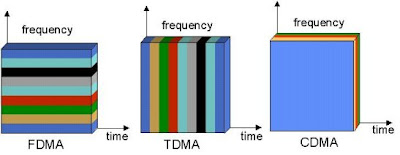CDMA (Code-Division Multiple Access) refers to any of several protocols used in so-called second-generation (2G) and third-generation (3G) wireless communications. As the term implies, CDMA is a form of multiplexing, which allows numerous signals to occupy a single transmission channel, optimizing the use of available bandwidth. CDMA, a proprietary standard designed by Qualcomm in the United States, has been the dominant network standard for North America and parts of Asia.
Coverage: The most important factor is getting service in the areas you will be using your phone. Upon viewing competitors' coverage maps you may discover that CDMA carriers offer cellular service in your area. If so, there is no decision to be made, but most people will find that they do have a choice.
For radio systems there are two resources, frequency and time. Division by frequency, so that each pair of communicators is allocated part of the spectrum for all of the time, results in Frequency Division Multiple Access (FDMA). Division by time, so that each pair of communicators is allocated all (or at least a large part) of the spectrum for part of the time results in Time Division Multiple Access (TDMA). In Code Division Multiple Access (CDMA), every communicator will be allocated the entire spectrum all of the time. CDMA uses codes to identify connections.
CDMA is a form of spread-spectrum, a family of digital communication techniques that
have been used in military applications for many years. The core principle of spread
spectrum is the use of noise-like carrier waves, and, as the name implies, bandwidths
much wider than that required for simple point-to-point communication at the same data rate. CDMA is a Direct Sequence Spread Spectrum system. The CDMA system works directly on 64 kbit/sec digital signals. These signals can be digitized voice, ISDN channels, modem data, etc.
CDMA is altering the face of cellular and PCS communication by:
· Dramatically improving the telephone traffic capacity.
· Dramatically improving the voice quality and eliminating the audible effects of
multipath fading.
· Reducing the incidence of dropped calls due to handoff failures.
· Providing reliable transport mechanism for data communications, such as
facsimile and internet traffic.
· Reducing the number of sites needed to support any given amount of traffic.
· Simplifying site selection.
· Reducing deployment and operating costs because fewer cell sites are needed.
· Reducing average transmitted power.
· Reducing interference to other electronic devices.
· Reducing potential health risks.
Thursday, July 30, 2009
Quick Tech Tip: CDMA - Code Division Multiple Access
Posted by
Sunflower
at
7/30/2009 06:10:00 PM
![]()
Labels: CDMA, Code Divison Multiple Access, digital, Multilexing, Spread spectrum, Technical Tip
|
| Subscribe by Email |
|
Subscribe to:
Post Comments (Atom)
No comments:
Post a Comment